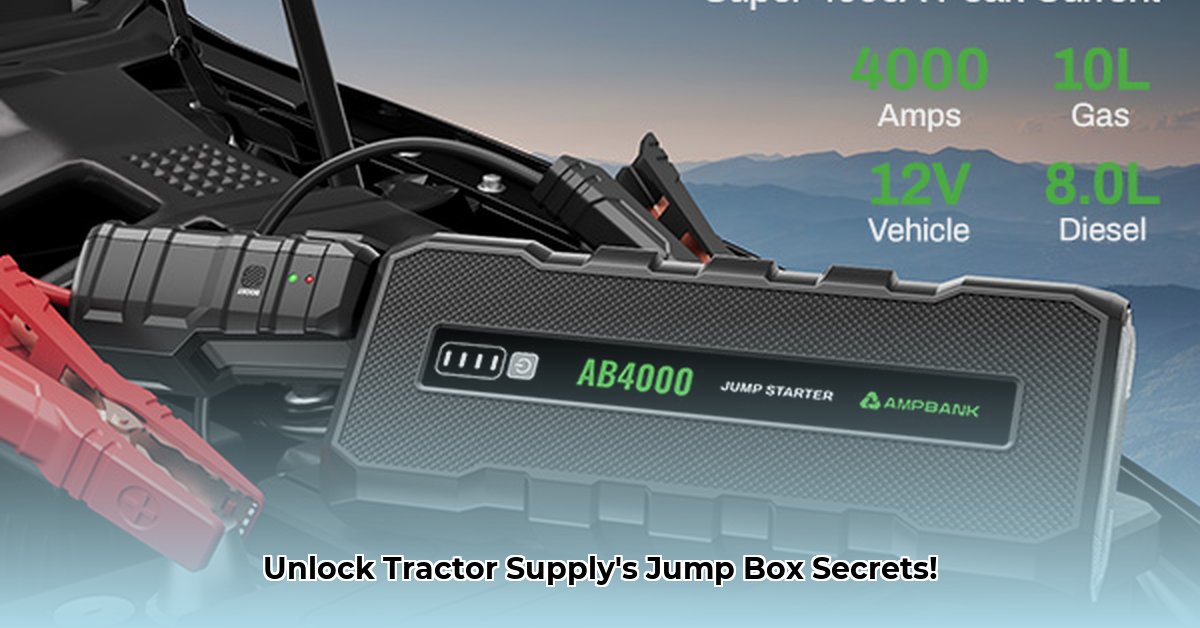
Getting stranded with a dead battery is a serious inconvenience, especially in rural or remote areas. A reliable jump starter can be a lifesaver, but choosing the right one from the wide selection at Tractor Supply can be confusing. This guide will help you navigate the process, ensuring you’re prepared for any dead battery emergency. For more information on powerful farm equipment, check out this link to additional resources.
Choosing the Right Jump Starter for Your Needs
Before you head to Tractor Supply, it's vital to understand the key specifications that determine a jump starter's performance and suitability for your vehicles. Let's break down the essentials.
Amperage: The Power Behind the Jump
You'll encounter two crucial amperage ratings: peak amps (PA) and cranking amps (CCA). Peak amps represent the initial burst of power, while cranking amps signify the sustained power needed to turn the engine over until it starts. Higher numbers in both categories mean more power – essential for larger engines like those found in tractors or heavy-duty trucks. For smaller vehicles like cars, lower PA and CCA ratings are often sufficient. Do you own a large tractor? A powerful jump starter with higher PA and CCA is necessary.
Battery Capacity: How Many Jumps Can You Get?
Battery capacity, measured in amp-hours (Ah), indicates how many jump starts the unit can provide before needing a recharge. A higher Ah rating means more jumps – a particularly valuable feature if you have multiple vehicles or live in an area with limited access to power. Are you frequently stranded with a dead battery? A jump starter with a high Ah rating might be a smart investment.
Extra Features: Added Convenience and Versatility
Beyond jump-starting capability, many jump starters offer additional features. These can significantly improve their usefulness. Many include:
- Air compressors: Ideal for quickly inflating flat tires.
- USB charging ports: Useful for charging phones or other devices in emergencies.
- LED work lights: Provide illumination in low-light conditions.
Durability and Ruggedness: Built for Tough Conditions
If you frequently use your vehicles in harsh environments, durability is a must. Look for a jump starter with a rugged, weather-resistant casing and heavy-duty clamps and cables. Do you operate in extreme environments? Opt for a durable model designed to withstand challenging conditions.
Safety Features: Protecting Your Vehicle and Yourself
Safety should be paramount. Essential safety features include:
- Reverse polarity protection: Prevents damage to your vehicle's electrical system if you accidentally connect the clamps incorrectly.
- Short-circuit protection: Prevents overheating and potential damage.
- Spark-proof clamps: Minimize the risk of sparks during connection.
Tractor Supply Jump Starters: Models to Consider
Tractor Supply offers a wide variety of jump starters. We cannot provide specific performance comparisons without thorough testing data, but this table illustrates the typical features of models you might find, allowing for informed decision making:
| Example Model Name | Peak Amps (Approx) | Cranking Amps (Approx) | Additional Features | Durability | Best Suited For |
|---|---|---|---|---|---|
| (Example: ToughStart 1000) | 1000 | 700 | None | High | Tractors, Large Vehicles |
| (Example: PowerBoost 500) | 500 | 350 | Built-in Air Compressor | Moderate | Cars, Small Trucks |
| (Example: All-In-One Pro) | 1200 | 800 | USB charging ports, LED light | High | Multiple Vehicles, Frequent Use |
Remember: Always verify specifications with the manufacturer before purchasing.
Safe Jump Starting: A Step-by-Step Guide
Step 1: Preparation is Key
Ensure both vehicle and jump starter batteries are compatible. Consult your vehicle's owner's manual for specific jump-starting instructions. Unsure? It's always best to consult a qualified mechanic.
Step 2: Connecting the Clamps
Red (+) clamp to the positive (+) terminal of both the dead battery and the jump starter. Then, attach the black (-) clamp to a substantial, unpainted metal surface (ground point) on the vehicle and to the negative terminal on the jump starter. Direct connection to the negative (-) terminal on the dead battery is also acceptable, but a ground connection is safer.
Step 3: Starting the Vehicle
Turn the ignition key. If it doesn't start immediately, wait briefly and try again. Avoid continuous cranking.
Step 4: Disconnecting the Clamps
Once the vehicle is running, remove the black clamp from the dead battery followed by the jump starter. Then remove the red clamp from the dead battery, followed by the jump starter. Disconnect in reverse order to minimize sparks and damage.
Step 5: Recharging Your Jump Starter
After each use, fully recharge your jump starter to maintain performance and prolong its lifespan.
Jump Starter Maintenance and Storage
Proper care significantly extends the life of your jump starter. Keep it clean, fully charged, and store it in a cool, dry place. Regularly inspect cables and clamps for wear or damage. Always refer to the manufacturer's instructions for specific maintenance advice.
Choosing and using a jump starter correctly can prevent potentially dangerous situations. By understanding the key features and following safe jump-starting procedures, you'll be well-prepared to tackle dead batteries whenever they arise.